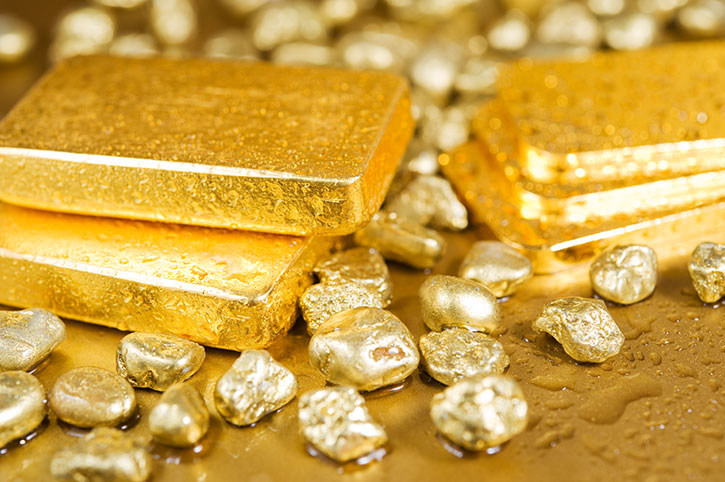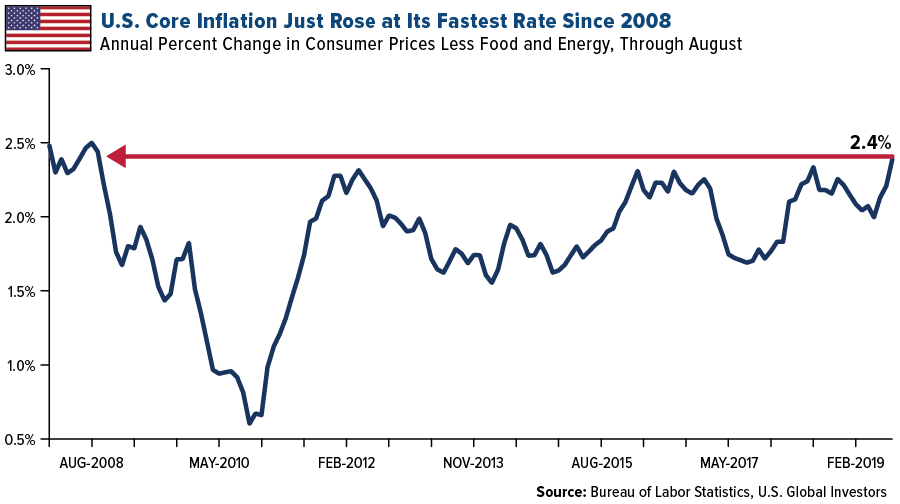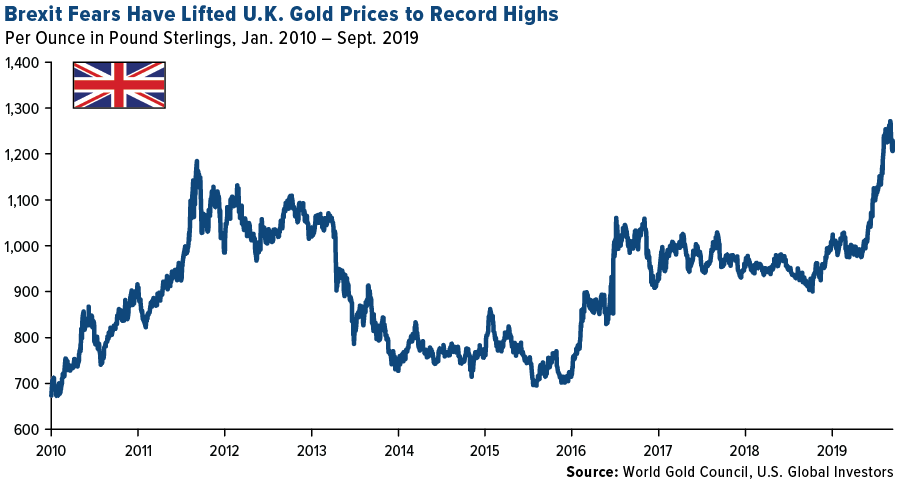
Gold may be off its 52-week highs, but the precious metal is still up more than 16 percent for the year through September 22. This appears to put gold on a path for its best year since 2010, when it gained just under 30 percent.
We believe buying the dips in gold right now could turn out to be a wise investment decision. A lot is happening at the moment—from an unprecedented $17 trillion in negative-yielding bonds worldwide to heightened geopolitical threats—that might boost investors’ appetite for the metal, which has a history of holding its value in times of crisis.
Here are three reasons why there could be further upside to gold prices, and how you can participate.
1. U.S. inflation is finally starting to heat up.
When President Donald Trump took office in January 2017, many market watchers expected consumer prices to climb rather quickly due to his protectionist policies and general skepticism of free trade agreements. Except for a blip here and there, inflation has remained pretty steady, even after hefty tariffs were imposed on goods imported from China.
That may be set to change, though, if the August inflation reading is any indication. “Core” consumer prices—which exclude volatile food and energy prices—rose to an 11-year high of 2.4 percent growth year-on-year. Not since September 2008 have prices expanded so fast.
Also of note: August saw the biggest monthly rise in medical care costs since 2016 as well as record increases in health insurance prices.
And remember, this doesn’t include the effects of the 15 tariffs on $112 billion in Chinese goods that the U.S. imposed on September 1.

In the past, faster inflation has been constructive for gold prices. That’s because inflation, by its nature, destroys your purchasing power, and to limit these losses, investors have traditionally turned to the yellow metal as well as gold mining stocks. So if you believe inflation is prepared to surge even more, it might make sense to add gold to your portfolio.
2. Negative yields in the U.S.?
As I mentioned earlier, as much as $17 trillion in debt around the world right now trades at a negative yield. This has recently pushed the price of gold to new all-time highs in a number of currencies, including the British pound, Japanese yen and Canadian and Australian dollars.
So far we haven’t seen negative yields in the U.S., at least not nominally. But it could only be a matter of time before U.S. fixed-income yields turn subzero—especially if Trump gets his way. The Federal Reserve has been under immense pressure to drop rates to a level that, in Trump’s eyes, is more competitive with those in Europe, Japan and elsewhere.
“The Federal Reserve should get our interest rates down to ZERO, or less, and we should then start to refinance our debt,” Trump tweeted on September 11. “The USA should always be paying the lowest rate.”
The Fed cut rates last week for the second time this year, and some analysts believe there could be as many as two more cuts in 2019. Should U.S. rates drop to “ZERO, or less,” to quote Trump, then we believe Treasury bonds and investment-grade corporate debt would lose their appeal as stores of value, and gold would be a direct beneficiary.
And if you’re doubtful that negative yields could possibly occur in the U.S., consider the recent words of Alan Greenspan, former Fed chairman: “There is no barrier for U.S. Treasury yields going below zero. Zero has no meaning, besides being a certain level.”
If you believe U.S. yields could soon break below this “barrier,” then gold might be a prudent investment decision.
3. Geopolitical and economic risks raise the demand for a safe haven.
There are a number of geopolitical and economic risks right now that have triggered gold’s “fear trade.” Economic growth is slowing worldwide as a result of trade tensions. Global factories, as measured by the JPMorgan Global Manufacturing PMI, have been in contraction mode for two straight months as of August.
Investors in the U.K. and elsewhere have turned to gold as the October 31 deadline for Brexit looms ever closer. With it looking more and more likely that the U.K. will leave the European Union (EU) without a deal, the price of gold in pound sterlings rose to an all-time high of 1,282 on September 3, an increase of more than 27 percent for the year.

Other geopolitical concerns, including unrest in Hong Kong as well as the recent attack on Saudi Arabia’s oil facilities, have helped support gold demand. Such concerns also help explain why global central banks have been net buyers of the yellow metal since 2010. The Netherlands’ central bank (DNB) recently explained why it continues to hold gold:
“Shares, bonds and other securities are not without risk, and prices can go down… If the system collapses, the gold stocks can help serve as a basis to build it up again. Gold historically bolsters confidence in the stability of the central bank’s balance sheet and creates a sense of security.”
How You Can Participate
One of the best ways to get exposure to gold, we believe, is with our U.S. Global GO GOLD and Precious Metal Miners ETF (GOAU).
GOAU is distinct for placing special emphasis on North American royalty and streaming companies, which we consider to be the “smart money” of the metals and mining space.
The three major players dominating the royalties space right now are Franco-Nevada, Wheaton Precious Metals and Royal Gold. Together, these three companies account for 30 percent of GOAU’s holdings, making it distinct among its peers.
Along with the added potential benefits of royalty stocks, we’re able to be highly selective in the producers we invest in. Close to 90 percent of the fund’s portfolio consists of high-quality small or mid-cap stocks, screened for profitability, cash return on invested capital (CROIC) and other factors.
The results, we believe, speak for themselves. GOAU was up an incredible 50.3 percent for the 12-month period as of September 20.
Ready to get started? Learn more about GOAU by clicking here!
Past performance does not guarantee future results.
| Fund | One-Year | Five-Year | Ten-Year | Since Inception | Gross Expense Ratio |
|---|---|---|---|---|---|
| U.S. Global GO GOLD and Precious Metal Miners ETF NAV | 12.15% | n/a | n/a | 9.06% (6/27/2017) | 0.60% |
| U.S. Global GO GOLD and Precious Metal Miners ETF Share Price | 11.20% | n/a | n/a | 8.62% (6/27/2017) | 0.60% |
The performance data quoted represents past performance. Past performance does not guarantee future results. The investment return and principal value of an investment will fluctuate so that an investor’s shares, when sold or redeemed, may be worth more or less than their original cost and current performance may be lower or higher than the performance quoted. Short term performance, in particular, is not a good indication of the fund’s future performance, and an investment should not be made based solely on returns. For GOAU performance data current to the most recent month-end please visit www.usglobaletfs.com.
All opinions expressed and data provided are subject to change without notice. Some of these opinions may not be appropriate to every investor.
The LBMA Gold Price is the global benchmark prices for unallocated gold delivered in London. The auctions are run at 10:30am and 3:00pm London time. The final auction prices are published to the market as the LBMA Gold Price AM and LBMA Gold Price PM. The Consumer Price Index (CPI) is one of the most widely recognized price measures for tracking the price of a market basket of goods and services purchased by individuals. The weights of components are based on consumer spending patterns. The JPMorgan Global Manufacturing PMI is compiled by IHS Markit, based on the results of surveys covering over 13,500 purchasing executives in over 40 countries. Together these countries account for an estimated 98% of global manufacturing output. Cash return on capital invested (CROCI) is metric that compares the cash generated by a company to its equity. It is also sometimes known as “cash return on cash invested”. It compares the cash earned with the money invested.
